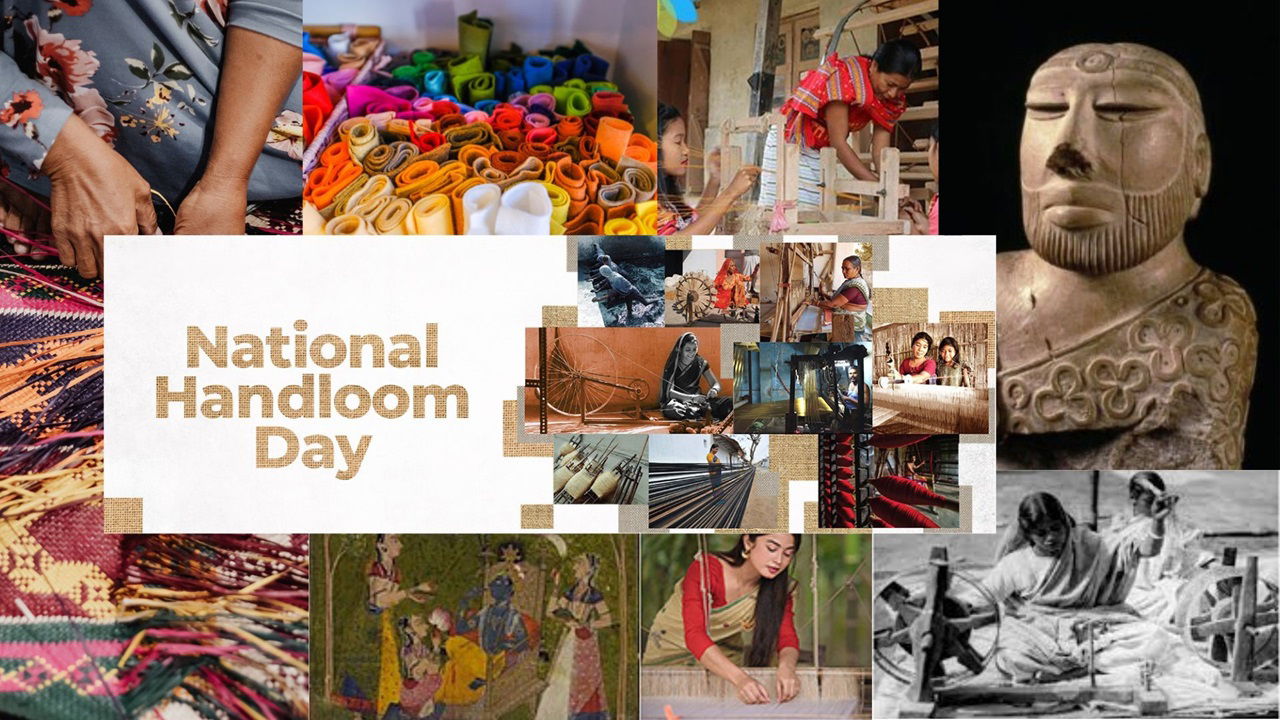
Every year, August 7th marks National Handloom Day in India, a significant occasion dedicated to honoring and promoting the rich tradition of handloom weaving that has been an integral part of the country's cultural and economic fabric for centuries. This day not only celebrates the artistry of handloom weavers but also underscores the historical journey and ongoing evolution of India's textile industry.
Rich History of Indian Textiles
India’s textile heritage is as ancient as its civilization, tracing back over 5,000 years to the Indus River Valley Civilization (3300–1300 BCE). Archaeological discoveries at sites like Mohenjo-Daro and Harappa reveal evidence of sophisticated weaving techniques and the use of cotton fibers, indicating that textiles were central to daily life.
The earliest references to Indian textiles come from ancient Sanskrit texts and inscriptions. The Rigveda, one of the oldest sacred texts of India, mentions fabrics like muslin and silk, which were highly valued. Over centuries, Indian textiles evolved, incorporating a variety of fibers, dyes, and weaving techniques that showcased the country’s rich diversity.
Flourishing Era of Handlooms
By the 3rd century BCE, handloom weaving had become a thriving industry in India. The Mauryan Empire, under the rule of Emperor Ashoka, saw advancements in trade and technology, further enhancing the spread of Indian textiles. The Silk Route played a crucial role in this period, facilitating the export of Indian silk and cotton fabrics to regions far beyond the subcontinent.
The Mughal era (1526–1857) is considered a golden age for Indian textiles. Mughals introduced new weaving techniques and a rich tradition of textile arts. Fabrics like brocade, satin, and velvet became popular, and the Mughal influence gave rise to intricate patterns and designs. The renowned Persian weavers brought with them techniques that enriched Indian textiles, leading to the creation of masterpieces like the Kashmiri shawls and Banarasi sarees.
During British colonial rule (1858–1947), the Indian handloom industry faced significant challenges. The introduction of mechanized mills and the export-oriented policies of the British Empire led to a decline in traditional handloom weaving. Despite these setbacks, handloom weaving remained a symbol of resistance and resilience. The Swadeshi Movement, which began in the early 20th century, played a crucial role in reviving handloom weaving as a patriotic act of defiance against British economic policies.
National Handloom Day: A Modern Revival
In 2015, the Government of India declared August 7th as National Handloom Day, marking the 1905 Swadeshi Movement's anniversary, which had a significant impact on the promotion of Indian handlooms. The primary goal of National Handloom Day is to celebrate the craftsmanship of handloom weavers and to promote the handloom sector as a source of sustainable livelihoods and cultural pride.
The handloom sector employs over 4.5 million people across India, making it one of the largest non-farm employment generators in the country. The sector is characterized by its diversity, with over 70 distinct weaving clusters producing a wide range of textiles, including sarees, shawls, and fabrics in different regions. States like Tamil Nadu, West Bengal, Assam, and Uttar Pradesh are renowned for their unique weaving traditions and products.
Figures and Facts: The Handloom Sector Today
-
Economic Contribution: The handloom sector plays a significant part in the rural economy and accounts for 13% of India's export revenues, 4% of GDP, and 14% of industrial production.
-
Employment: The handloom industry is the second-largest employment sector in India after agriculture. According to the Handloom Census 2019-20, the industry employs 35.22 lakh workers nationwide, out of which 25.46 lakh are women. Additionally, 26.73 lakh rural artisans are involved in the industry, with women making up 72% of the workforce.
-
Export Value: Handloom products have a significant export value, with India exporting textiles worth approximately ₹44,000 crore (about USD 44 billion) annually.
Challenges and Opportunities
Despite its rich heritage and contributions, the handloom sector faces several challenges. The rise of mechanized textiles and competition from cheaper synthetic fabrics has affected the demand for handloom products. Additionally, the sector struggles with issues related to marketing, infrastructure, and access to modern technology.
To address these challenges, various initiatives have been introduced, including the National Handloom Development Programme (NHDP). Government schemes like the MUDRA Scheme for Weavers and the Handloom Weavers’ Comprehensive Welfare Scheme support weavers, promote handloom products, and enhance the sector’s sustainability. Moreover, the Handloom Mark certifies genuine handloom products, and the establishment of handloom parks aims to improve the visibility and market reach of handloom textiles.
National Handloom Day serves as a poignant reminder of the intricate craftsmanship and historical significance of India’s handloom industry. It celebrates the legacy of handloom weavers who have preserved traditional techniques and contributed to the country’s rich cultural tapestry. As we honor this day, it is essential to support and promote the handloom sector, ensuring that it continues to thrive and enrich the lives of millions across India.
















